September 4, 5 and 17 Field Outings to Observe Juvenile Trout Stranding
A year after Whitefish Ed and his fishing partner witnessed and documented some significant flow reduction stranding of South Fork Boise River juvenile trout, the Ted Trueblood Chapter of Trout Unlimited prompted, organized and collaborated with biologists from the Bureau of Reclamation (BOR) and Idaho Department of Fish and Game (IDFG) and other angler groups to better assess the problem.
The assessments occurred September 4-5 during the first flow reduction, and September 17 during the second flow drop.
As way of background, BOR routinely cuts summer flows at Anderson Ranch Dam down to 600 cfs sometime in August or September when irrigation water demands begin to be fall off.
Flows are again reduced from 600 to 300 cfs later in September, usually no earlier than September 15th. These flow cuts are rapid and believed to have catastrophic effects on macroinvertebrates and young fish that are hugging shallow shoreline margins or living in low velocity backwaters and side channels. Up until this year, there had been little effort to scrutinize what actually happens.
On Tuesday, September 4, BOR began cutting flows at 8 a.m. in 300 cfs increments from the summertime irrigation flow level of 1800 cfs every two 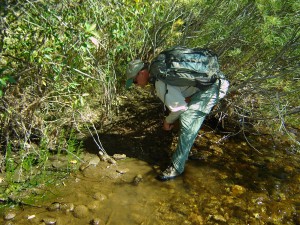 hours until reaching 900 cfs at 1 p.m. Again on the next day, and at 9 a.m., flows were reduced to 600 cfs. These flow reductions mimicked the normal operational flow cut schedule at the dam. A group of 1 TU and 3 IDFG biologists teamed with 5 volunteers on September 4 to observe and tally the incidence of bug and fish stranding along four different reaches of the river.
hours until reaching 900 cfs at 1 p.m. Again on the next day, and at 9 a.m., flows were reduced to 600 cfs. These flow reductions mimicked the normal operational flow cut schedule at the dam. A group of 1 TU and 3 IDFG biologists teamed with 5 volunteers on September 4 to observe and tally the incidence of bug and fish stranding along four different reaches of the river.
Whitefish Ed chose to stay put at a shallow bank section below Cow Creek Bridge to watch the reaction of hundreds of juvenile trout as flow reductions showed up. This was the location where he had observed and related significant fish stranding the year before.
The next morning on September 5, these same biologists combined with 3 volunteers to retrace their steps and look for stranded fish when the flow was finally dropped to 600 cfs.
Twelve days later, on Monday, September 17, a total of eight biologists with TU, BOR and IDFG teamed with about two dozen angler volunteers to be on the river when the final flow cuts were made to reach the minimum flow of 300 cfs.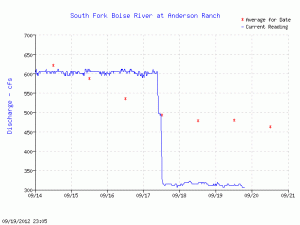 In addition to Ted Trueblood Chapter members, other angler groups included the Hemingway Chapter, Boise Valley Fly Fishers, and Gem State Fly Fishers. TU provided a night-before dinner, and on the day of the field work a light breakfast and lunch at the “camp central” location at Reclamation Village for everyone involved. This larger group allowed for more river sections to be investigated. The river was dropped 100 cfs at 9 a.m. and another 200 cfs at 11 a.m.
In addition to Ted Trueblood Chapter members, other angler groups included the Hemingway Chapter, Boise Valley Fly Fishers, and Gem State Fly Fishers. TU provided a night-before dinner, and on the day of the field work a light breakfast and lunch at the “camp central” location at Reclamation Village for everyone involved. This larger group allowed for more river sections to be investigated. The river was dropped 100 cfs at 9 a.m. and another 200 cfs at 11 a.m.
RESULTS: Right now, the jury is out. The data collected during our two outings have not been evaluated and compiled into a report by the biologists as yet. Each group that was deployed to the river had a person with a clipboard to write down information on stranding sites, including information such as the size of the pool (length, width and average depth), a GPS waypoint if someone in the group had such a device, and numbers and species of fish stranded. Participants were asked to bring a digital camera, and as this article shows we created ample documentation of the event. More than 200 photographs can be viewed here.
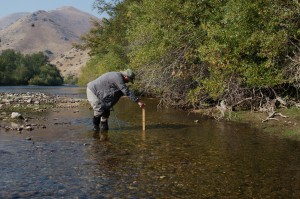
Dick Frencer with Boise Valley Fly Fishers measures water depth, somewhere downstream of Cow Creek bridge. Photo Credit: John Wolter.
During the course of our on-river evaluation, many of us observed great numbers of “young of the year” juvenile trout that could be readily seen along low velocity and shallow shore line margins. These age-0 fish (young fish that have hatched and emerged from spawning redds this last spring/summer) are said to be subject to 70 – 80% mortality in the winter ahead. The incidence of stranding when flows are lowered is directly related to the character of the river at any specific location.
Preliminary observations were that stranding appeared to be more catastrophic within the 600 to 300 cfs flow reduction regime as more shallow water and side channels were subjected to dewatering. Everyone involved observed different amounts of stranding based on the specific river sections they were looking at. Ed filed his report here.
Last year, the flow cuts occurred in the darkness of early morning hours; this year flow reductions were implemented during daylight which could somehow reduce the amount of stranding. Significant stranding of stoneflies and caddisflies were observed, indicating that these organisms cannot readily follow rapidly receding water.
A summary report of our study findings should be completed by our biologist partners later this fall. If there is biological justification, we believe there could be opportunity to modify the BOR downramping regimes at Anderson Ranch Dam to help lower fish and insect stranding. Next year, we may want to repeat this study using a different flow drop schedule. Stay tuned.
The Macroinvertebrate Effects of Downramping
To help evaluate the effects of dropping flows on aquatic insects, the TU Ted Trueblood Chapter contracted with Dr. Chris Walser, Professor of Biology at College of Idaho. C of I students are participating in the assessment. Dr Walser’s approach focuses on the flow reduction of 600 to 300 cfs, looking at pre and post conditions. Macroinvertebrates were collected at shallow riffle sites on Tuesday, September 11, before downramping and then again at the same locations on September 18, following the final flow cut to 300 cfs.
A total of 60 samples were taken. These samples will be sorted to the lowest practical taxonomic level, enumerated and weighed. A concluding report will be completed and provided to TU in December. This unique scientific study should shed some significant light on losses to the macroinvertebrate community when rapid flow drops occur on the South Fork Boise River.
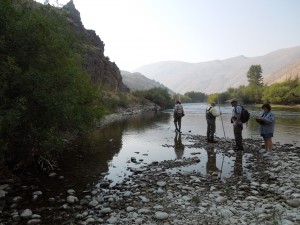
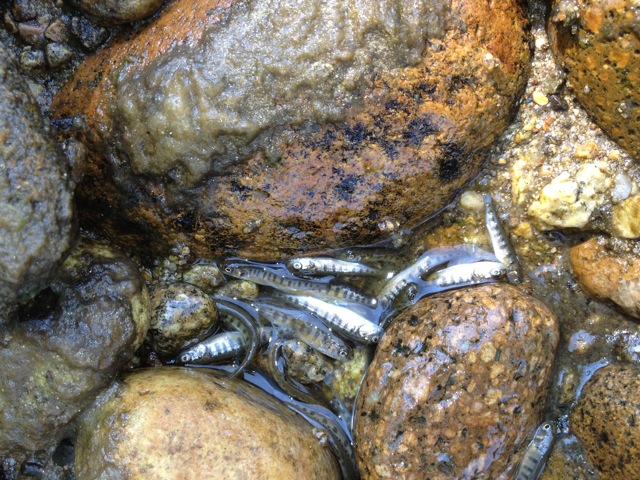
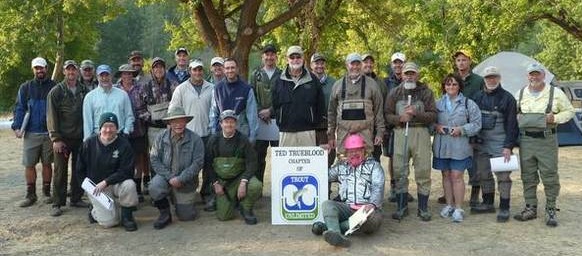
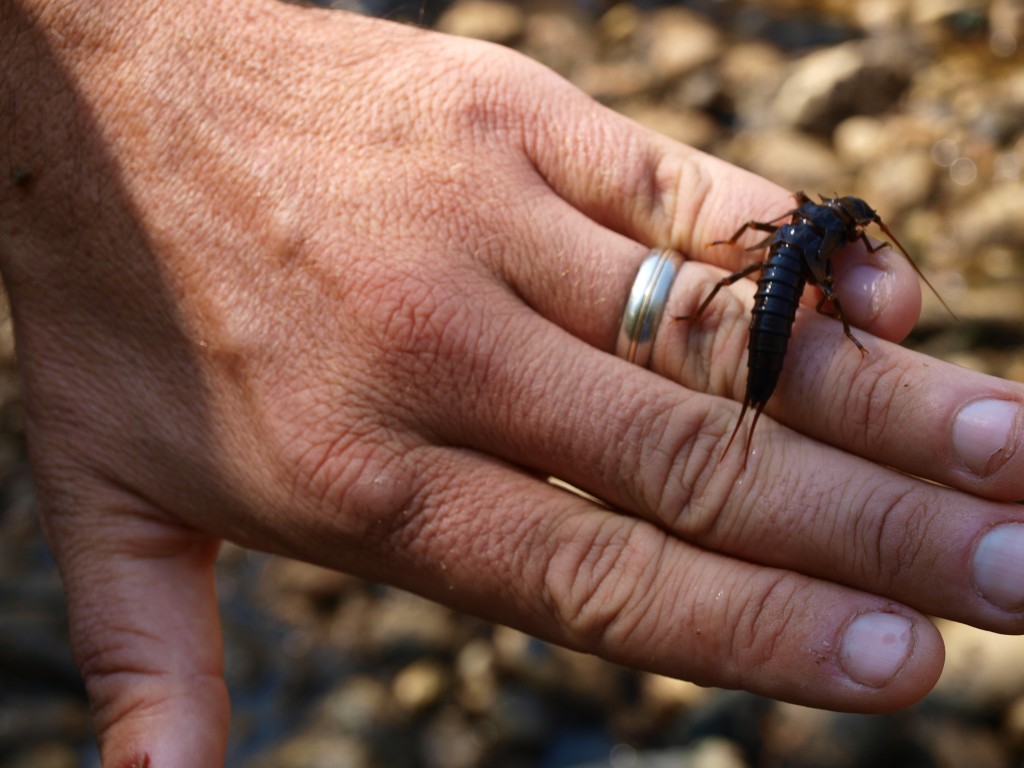







Pingback: Salute to Whitefish Ed – 2012 Man o’ the Year for 2012 |
Pingback: South Fork is Ultimate Winner Again of Fly Casting Tournament |